Emotions are often perceived as “energy in motion,” intangible experiences, residing somewhere in the mind and heart, influencing our mood and decisions. But what if we shifted our perspective and saw emotions as more than this vague “energy in motion” definition? What if we viewed them as powerful suggestions—nudges, if you will—that prompt us to move, to speak, and to act?
At its core, the word emotion shares its roots with motion, highlighting the biological connection between how we feel and how we move. The word “emotion” is derived from the Latin root emovere. This root is a combination of the prefix e- (meaning “out” or “away”) and the verb movere (meaning “to move”). Therefore, emovere literally means “to move out” or “to set in motion.”
Emotions are not just feelings that passively wash over us; they are signals from our brain, pushing us toward action sometimes as subtle suggestions, at at other times as loud, fairly impossible to ignore commands.
Many say emotions are “energy in motion” but literally everything — even every keystroke I am typing right now is energy in motion. A thought is energy in motion. Digesting your breakfast is energy in motion. So…
Instead of saying “Emotions are energy in motion,” say “Emotions are suggestions to move.”
‘ Jessika Jake
The Survival Function of Negative Emotions (Negativity)
Negative emotions like fear, anger, and disgust are the brain’s way of signaling that something is wrong and that immediate action is needed. These emotions come with rigid action tendencies—specific, hardwired responses.
- Fear and sympathetic activation are besties, and the sequence can vary of course, but here we consider: Perception of threat (via neuroception)→ Sympathetic activation → Fear (fight or flee)
- Anger drives us to defend ourselves, assert boundaries, and protect what is ours. (Even the “hangry” state is helpful/”helpful” because the body is trying to claim resources, in this case, FOOD.)
- Disgust prompts us to expel or avoid substances that could be harmful, whether it’s rotten food or toxic social interactions.
These responses are incredibly efficient and serve as quick, automatic ways to ensure our immediate survival. When we’re in danger, there’s no time to weigh options—our bodies and minds need to act fast. This rigidity is a feature, not a bug, of negative emotions. Here the suggestion to move is quite loud and hard to ignore. For example, don’t naturally have the ability to ignore the recoil response that is paired with fear when there is a loud crash near us.

The Flexibility of Positive Emotions
In contrast, positive emotions like joy, love, gratitude, awe, serenity, curiosity, etc. emerge when we feel safe. These emotions don’t push us toward a specific action in the same way negative emotions do. Instead, they open up a range of possibilities, encouraging exploration, creativity, and connection. Dr. Steven Ruden coined the term e-notion to encompass all of these possibilities.
- Joy makes us more open to new experiences and willing to make moves in the adventure zone, which can lead to personal growth and stronger social bonds.
- Love fosters deep connections with others, essential for long-term survival and cooperation.
- Curiosity drives us to learn and explore, expanding our understanding of the world.

Positive emotions are more about long-term survival—they help us build relationships, learn new skills, and create environments where we can thrive. This flexibility is key to human development, allowing us to adapt and flourish in diverse environments.
A Closer Look at Negativity and Positivity (Excerpt from Escaping Ever-Stressed Mode, circa 2019)
The Internal Landscape: Shaped by Genetics, Experience, and More
Our emotional responses and tendencies are not just random—they are shaped by a complex interplay of factors including genetics, epigenetics, upbringing, personal experiences, and even the traumas we’ve endured. These elements create an internal landscape, a landscape that also interplays with the parts of our personality that come to the forefront in various situations.
- Genetics provide a baseline, so to speak
- Epigenetics show how our environment can switch certain genes on or off, affecting how we respond to certain situations. Some responses are transmitted to the next generation via epigenetics.
- Modeling from caregivers and influential figures also comes into play
- Personal Experiences and Traumas also change our internal landscape
- Personality Parts are the parts we are born with, but how they show up to help is shaped by all of the above, and more
Marston’s Quest to Understand consciousness
William Moulton Marston, the mind behind the DISC model, was deeply fascinated by the complexity of human emotion and behavior. He sought to categorize the emotions that drive us, attempting to make sense of how these internal states translate into external actions. But Marston didn’t stop there—he even pondered the origins of consciousness itself, wondering when, why, and how emotional and motor consciousness arise in our bodies. (I use a lower case c here in consciousness, because we have a foundational I-am-ness, Conscious Awareness in which these forms of consciousness arise.) This sounds weird yes, but he basically cared about when the biochemistry, etc. took on consciousness. I’m not being all doom and gloom, “When you die, you die,” not at all. I personally believe that the foundation of being-ness, our Conscious Awareness is the what of what we truly are.
Marston’s work was an early attempt to map the terrain of our inner world, recognizing that emotions are part of a sophisticated system designed to help us navigate the world — helping us stay safe and get good at humaning. He understood that consciousness—the awareness of our emotions and the actions they prompt—is key to understanding not just the who-ness of “who” we are, but how we survive and thrive.
Almost a Century of DiSC
William Moulton Marston’s work spurred the use of the DISC model to categorize and describe four primary human emotions and behavioral tendencies. He documented Dominance, Inducement, Submission, and Compliance in his 1928 book called The Emotions of Normal People. His intention was to understand how people express themselves in different situations, particularly in terms of their interactions with others and their environment. These four designators he crafted were meant to describe different patterns of human behavior and emotional expression:
- Dominance (D): Characterized by assertiveness, control, and a desire to overcome challenges. People who score high in Dominance tend to be direct, strong-willed, and focused on achieving results.
- Inducement (i): Associated with sociability, enthusiasm, and the ability to persuade or influence others. Individuals high in Inducement / influence are often outgoing, talkative, and motivated by social recognition.
- Submission (S): Reflects patience, calmness, and a preference for stability and cooperation. Those with high Submission / Steadiness are generally dependable, loyal, and supportive, preferring a harmonious environment.
- Compliance (C): Linked to a focus on accuracy, order, and adherence to rules. High Compliance individuals are meticulous, cautious, and driven by the need for quality and correctness.
Many gravitated towards his work because it is super-helpful. For nearly a century people have been labeling themselves and others as D’s, i’s, S’s and C’s. But the reality is: We are not our personality. We have personality parts. Not only are we NOT our personality, but personality is NOT a simple, single entity but rather a plurality or multiplicity. We experience multiplicity of mind, a multiplicity of parts, each with its own desires, fears, and strategies for navigating the world. These parts work together, sometimes in harmony, sometimes in conflict, to help us respond to the challenges and opportunities life presents.
If we can spot the common 4 parts in ourselves and others, it is really helpful. For example, these are the intrinsic motivators we see when it comes to the common 4 parts:

Each of us is made up of numerous personality parts beyond the four designators explored by by Marston and updated in 2024 to reflect contemporary neuroscience (multiplicity of mind, neurodiversity, subcellular trauma-encodings, stress induced neuroplasticity, etc).
Our parts can take on different roles depending on the situation—sometimes we might need our “Boss” part to take charge, while at other times, our “Caretaker” part steps in to nurture and support those around us. Our parts show up differently if we are in the physiology of safety and connection, vs sympathetic activation, etc. Our personality parts always, always, always have helpful intent.
The Part That’s Not a Part: The Omniversal Self
Yet, there is something even more profound within us—what can be referred to as the Omniversal Self, the part that is not a part. This is the core of our being, the foundation of beingness, the Consciousness that is the core of our what-ness. It is the aspect of ourselves that is constant, even as the various parts of our personality shift and change depending on our circumstances. This Omniversal Self can lead our parts. It can shine through us like a light that never goes out.
In recognizing multiplicity of mind and the presence of Omniversal Self, we gain a deeper understanding of what we are: our foundational and constant what-ness in which our ever-changing who-ness arises… the “being” part of the term “human being,” if you will. We are not just a Dominance, Influence, Steadiness, or Conscientiousness type—we have many, many parts, all showing us to help us do this humaning thing. Embracing this complexity allows us to move beyond simple labels and into a fuller, more nuanced understanding of ourselves and others. It allows us to change our relationships with our parts, help parts change their relationships to each other, help parts drop their shields, and help unobsure Omniversal Self, more and more, so that inner team work can truly make the dream work.
